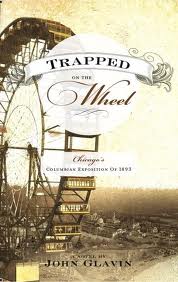Trapped on the Wheel
The vast tapestry of possibilities that was the Chicago World’s Fair of 1893 is brought to vivid life as the setting and metaphor for a young woman’s awakening in John Glavin’s Trapped on the Wheel. Alessandra Aultman, who turns 18 on the eve of the Fair, is eager to fulfill all the roles in her life and be a perfect daughter, sister, and girlfriend. As the Fair opens, so does Alessandra’s mind—to new experiences, thoughts, and people. Her journey parallels the Fair, sharing both its triumphs and tragedies, until she must face the question of who she truly wants to be.
Glavin’s prose is highly evocative, bringing out the overwhelming atmosphere of the Fair in detailed descriptions of its sights, sounds, tastes, and smells. The Fair is as much a character as a setting as Alessandra attempts to use it as first an escape, then a guide to her own life. She quickly finds that the Fair’s gilded and polished front hides a darker underside, much as her own quiet demeanor hides a rebellious spirit.
While the Fair is a fascinating setting, which is compelling on its own, the novel suffers from a lack of internal logic. The characters’ actions often feel forced or utterly bizarre, and several plot threads seem to trail off as the book progresses, leaving the story feeling incomplete. A planned sequel may explain this and will hopefully feature a setting as delightful and extraordinary as the World’s Fair.










